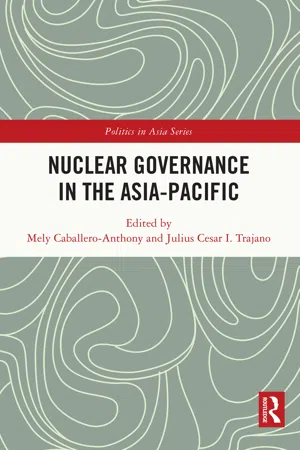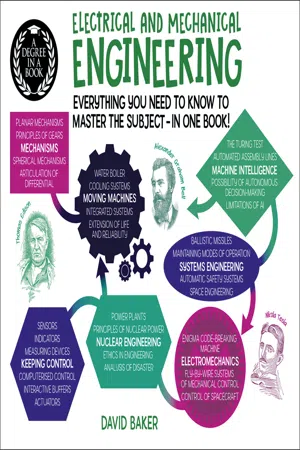Technology & Engineering
Nuclear Engineering
Nuclear engineering involves the study and application of nuclear energy, including the design, development, and operation of nuclear power plants and other nuclear systems. It encompasses various aspects such as nuclear fission, fusion, and radiation protection. Nuclear engineers work on developing safe and efficient methods for harnessing nuclear energy for power generation and other industrial applications.
Written by Perlego with AI-assistance
Related key terms
Related key terms
1 of 4
Related key terms
1 of 3
3 Key excerpts on "Nuclear Engineering"
- eBook - ePub
- Mely Caballero-Anthony, Julius Cesar I. Trajano, Mely Caballero-Anthony, Julius Cesar I. Trajano(Authors)
- 2022(Publication Date)
- Routledge(Publisher)
Table 7.1 lists undergraduate- and graduate-level courses offered at the Department of Nuclear Engineering, Faculty of Engineering, Chulalongkorn University. That should provide interested readers with the basic curriculum generally taught in degree programmes in nuclear science and engineering.Table 7.1 Undergraduate- and graduate-level courses at the Department of Nuclear Engineering, Faculty of Engineering, Chulalongkorn University.Undergraduate level Graduate level - Essence of Nuclear Engineering
- Basic Principle of Nuclear Radiation Detection and Measurement
- Nuclear Radiation Detection and Measurement Laboratory
- Health Physics and Radiation Protection
- Introduction to Nuclear Materials
- Nuclear Power Plant Technology
- Nuclear Reactor Analysis
- Environmental Aspects of Nuclear Engineering
- Industrial Control Electronics
- Principle of Nuclear Instrument
- Industrial Uses of Radiation and Radioactive Material
- Industrial Uses of Radiation and Radioactive Material Laboratory
- Electronic Circuits for Nuclear Instruments
- Nuclear Reactor Laboratory
- Nuclear Reactor Safety
- Radiation Machines I
- Nuclear Safety, Security and Safeguards
- Seminar in Basic Nuclear Engineering
- Project in Nuclear Engineering
- Ionising Radiation Calibration and Dosimetry
- Plasma Physics and Applications
- Nuclear Techniques for Material Analysis
- Nuclear Technology in Medicine
- Nuclear Techniques for Measurement and Inspection in Industrial Process
- eBook - ePub
A Degree in a Book: Electrical And Mechanical Engineering
Everything You Need to Know to Master the Subject - in One Book!
- David Baker(Author)
- 2021(Publication Date)
- Arcturus(Publisher)
Atomic potential There is one field of engineering that touches several applications, ranging from the design and development of civil and commercial commissions to the cutting edge of military requirements. It embraces the field of utilities on one hand and the development and deployment of the most destructive instruments of war known to humans on the other. Nuclear Engineering covers many separate fields, but all are catalyzed by one enabling scientific process: energy contained within an atom. Unravelling the physics of the atom occupied scientists for the first several decades of the 20th century until Otto Hahn (1879–1958) and Fritz Strassman (1902–80) became the first to split the atom (1938) – a fission that unlocked virtually limitless amounts of energy for engineers to harness and governments to invest in – primarily for electrical power and for an explosive device colloquially known as the atomic bomb. Today, nuclear energy is the bedrock of power production in many countries, presently providing 11 per cent of the world’s electricity (424 GW) from 430 nuclear reactors, of which about one-quarter are in the USA, a country that gets 20 per cent of its energy from this method. At the other end of the spectrum, nuclear weapons remain a mighty force and a potent threat, but while they are considered a ‘deterrent’, they will continue to be a part of the defence infrastructure in several countries around the world - Abdullah Al Faruque(Author)
- 2018(Publication Date)
- Routledge(Publisher)
Nuclear energy is currently contributing about 17 per cent of the total global electricity production. Nuclear material and technology is also useful for medicine and agriculture. The justification for a nuclear revival has been based largely upon two policy priorities: climate change mitigation and security of energy supply. 3 Nuclear energy is often considered a clean non-renewable energy source in terms of emissions. From an emission standpoint nuclear energy is more environmentally friendly than coal, oil or gas. The importance of nuclear energy is increasing since it is capable of meeting a significant portion of the energy needs of a country. Thus, nuclear power should be considered as one of the significant options for meeting future world energy needs at low cost and in an environmentally acceptable manner. Nuclear energy has assumed growing significance as emission-free energy in an era of serious concern about global warming. 4 In order to improve public perception of the nuclear industry, the issue of safety and waste management need to be further developed and addressed and the industry must continue to pursue a policy of non-proliferation of nuclear weapons. Risk factors in nuclear energy Although nuclear technology is currently applied in diverse areas of human activity, such as medicine, nuclear research, agriculture and food preservation, the main risk stems from the generation of nuclear energy from the nuclear power plant. The nuclear power plant is the main part in the nuclear fuel cycle chain, and it is the place where the fission process occurs. 5 Other parts of the nuclear fuel cycle include the transportation of nuclear materials and the management and transportation of spent fuel and nuclear waste. 6 Thus, the sources include all types of nuclear facilities, such as power reactors, research reactors, nuclear fuel cycle facilities, etc, as well as medical, research and industrial sources, and defence-related sources where appropriate
Index pages curate the most relevant extracts from our library of academic textbooks. They’ve been created using an in-house natural language model (NLM), each adding context and meaning to key research topics.
Explore more topic indexes
Explore more topic indexes
1 of 6
Explore more topic indexes
1 of 4


